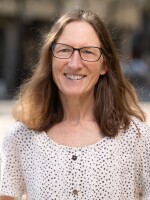Many older urban areas have a broken sidewalk grid, posing various safety risks. One Eugene neighborhood has a model for a how to infill missing sidewalks without over-burdening individual property owners.
In 2008, the Friendly Area Neighbors group, or FAN, wanted to start a walking program. Members envisioned routes of varying lengths that would bring the community together. There was just one problem, said FAN transportation committee leader Carlos Barrera: “We were surprised to find out that there were no through sidewalks down to the business district.”
Nor were there straight paths to area schools, public transportation or downtown. The solution? More sidewalks. But it would come at a cost…a cost that would fall on the backs of the people who live there.

“Unlike how we finance roads, streets, how we finance community paths, bikeways, those are all shared among communities as a whole but sidewalks are not," said Heather Brinton, who serves on the neighborhood group’s transportation committee.
Brinton said they had to think creatively to meet the goals of safe pedestrian connectivity, while not burdening property owners. The group told KLCC the cost for an average homeowner in the neighborhood to add a sidewalk is about $10,000, not including tree removal or changes to in-ground sprinklers or retaining walls.
The committee found some solutions, and is poised to add a block of sidewalks this year. More on that later.
But first: How did we get here?
New construction requires sidewalks, but that wasn’t always the case, explained Marion Suitor Barnes, a spokesperson for the City of Eugene.
“You’ve got parts of town, like older parts of town, where the code for what a sidewalk looked like was way different when those parts of town were made,” she said.
Suitor Barnes said filling in missing sidewalks fits several of the city’s improvement goals, and many can be paid for with grants. “So when you’re asking the government for money," she said, "you can say it's for Safe Routes to Schools, you can say it's for Vision Zero, you can say, you know, it's for climate. There's of course ADA reasons too.”
Vision Zero aims to reduce traffic-related deaths and injuries; Eugene’s climate action plan focuses on lowering fossil fuel use, and recent ramp and curb projects fulfill the Americans with Disabilities Act accessibility requirements.
Suitor Barnes said the city is responsible for sidewalks on public properties or flanking public rights of way. Otherwise, it’s up to homeowners to add sidewalks and maintain them.
“There are 770 miles of sidewalks in the city, so we can't do it all ourselves,” she said.

Strategies for completing the project
The Friendly Area Neighbors’ solution involves a variety of tactics.
When the group completed an area of new sidewalks in 2008, some homeowners paid for the project themselves. Others were covered by a private fund set up by the neighborhood group. People who had the means paid into the fund to help their neighbors who didn’t.
After years of delays, including the pandemic and some homeowners not wanting to remove trees or re-plant gardens, FAN is ready to move forward on another sidewalk project. This one will provide a connection to the Willamette Street business district.
In addition to using donations, Barrera hopes to save costs by submitting the project under one permit. And, he said, the city has offered some help.
“They’ve volunteered to do all the access ramps, of which there are like 11," he said. "That would be a major cost if we had to do those as well.”
Barrera said by pooling neighborhood resources, they’ll be able to hire a contractor to work on 19 properties in one go.
Many people in the community are ready for the work to begin, he said, while flipping through photos he’s taken in the area.
“Some elderly people are somewhat trapped in their homes if there are no sidewalks," he said, pointing to a picture of a man and his caretaker. "This is Vern. He used to live just through the walkway down here, and he could only walk just this one block, back and forth.”
Barrera has photos of neighbors with wheelchairs and strollers, as well as a nearby daycare and scores of school-aged kids, all of whom have had to use the streets to get around.
This year’s sidewalk construction could be just the beginning.
“We’re also hoping that this project will be a model for other neighborhood associations," he said, "in terms of working with the city to put in infrastructure that they need, and show that, well, you don’t have to sit back and wait for the city to get the funding to do stuff. I kind of think that if this kind of works out, everybody wins.”
©2025 KLCC News



